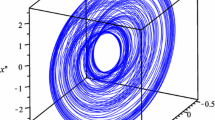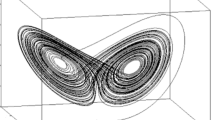Abstract
A central problem for a dynamic formulation of macroeconomic theory is how to explain the occurrence of different, relatively well-defined economic modes such as the short term business cycle, the construction (or Kuznets) cycle, and the economic long wave (or Kondratiev cycle). Equally important is a description of the various phenomena that can arise through interaction between these cycles. Modern nonlinear theory suggests that different cyclical modes may be entrained through the process of mode-locking, where the periods of the interacting modes adjust to one another, so as to attain a rational ratio. This type of interaction is well documented in physical and biological systems. However, despite the importance of the problem and abundant evidence for nonlinearity in the economy, modern concepts of nonlinear mode-interaction have not yet been applied to the problem of entrainment between economic cycles. We show how mode-locking and other highly nonlinear dynamic phenomena arise in a model of the economic long wave. The behavior of the model is mapped as a function of the frequency and amplitude of an external forcing, producing both a devil's staircase and a detailed Arnol'd tongue diagram. Two different routes to chaos are identified. The Lyapunov exponents are calculated, allowing the strength of the chaos to be assessed, and the fractal nature of the basins of attraction for two simultaneously existing periodic solutions is illustrated. The paper concludes with a discussion of the implications for economic theory.
Similar content being viewed by others
References
W.C. Mitchel,business Cycles: The Problem and Its Setting, National Bureau of Economic Research, New York (1927).
H.G. Moore (ed.),Business Cycle Indicators (Princeton University Press, New Jersey, 1961).
V. Zarnowitz, Recent work on business cycles in historical perspective: A review of theory and evidence, J. Econ. Literature 23(1985)523–580.
J.R. Riggleman, Building cycles in the United States, 1897–1932, J. Amer. Statist. Assoc. 28(1933)182.
C.D. Long, Jr.,Building Cycles and the Theory of Investment (Princeton University Press, New Jersey, 1940).
S. Kuznets, Modern economic growth: Findings and reflections, Amer. Econ. Rev. 63(1973)247–258.
N.D. Kondratieff, The long wave in economic life, Rev. Econ. Statist. 17(1935)105–115.
W.W. Rostow,The World Economy. History and Prospect (MacMillan Press, London, 1978).
H. Bieshaar and A. Kleinknecht, Kondratieff long waves in aggregate output? An economic test, Konjunkturpolitik 30(1984)279–303.
T. Vasko (ed.),The Long Wave Debate (Springer, Berlin, 1987).
J.A. Schumpeter,Business Cycles (McGraw-Hill, New York, 1939), p.173.
M.H. Jensen, P. Bak and T. Bohr, Complete devil's staircase, fractal dimension, and universality of mode-locking structure in the circle map, Phys. Rev. Lett. 50(1983)1637–1639.
M.H. Jensen, P. Bak and T. Bohr, Transition to chaos by interaction of resonances in dissipative systems. I. Circle maps, Phys. Rev. A30(1984)1960–1969.
J.D. Sterman, A behavioral model of the economic long wave, J. Econ. Behavior and Organization 6(1985)17–53.
A. Raff, Dynamics of the tankship industry, SM Thesis, Department of Ocean Engineering, MIT, Cambridge, MA (1960).
Z. Zannitos,The Theory of Oil Tanker Rates (MIT Press, Cambridge, MA 1966).
J. Randers, The tanker market, Working Paper 84/9, Norwegian School of Management, Oslo (1984).
J. van Duijn,The Long Wave in Economic Life (Allan and Unwin, London, 1963).
E. Mansfield, Long waves in technological innovation, Amer. Econ. Assoc., Papers and Proc. 73(1983)141–145.
N. Rosenberg and C.R. Frischtak, Long waves and economic growth: A critical appraisal, Amer. Econ. Assoc., Papers and Proc. 73(1983)146–151.
J.D. Sterman, The economic long wave: Theory and evidence, System Dynamics Rev. 2(1986)87–125.
J. Goldstein,Long Cycles: Prosperity and War in the Modern Age (Yale University Press, New Haven, 1988).
S. Rasmussen, E. Mosekilde and J. Holst, Empirical indication of economic long waves in aggregate production, Eur. J. Oper. Res. 42(1989)279–293.
J.D. Sterman, Misperceptions of feedback in dynamic decision making, Organizational Behavior and Human Decision Process 43(1989)301–335.
E. Mosekilde and S Rasmussen, Technical economic succession and the economic long wave, Eur. J. Oper. Res. 25(1986)27–38.
R. Frisch, Propagation problems and impulse problems in dynamic economics, in:Readings in Business Cycles, ed. R. Gordon and L. Klein (Irwin, Homewood, IL, 1933).
P.A. Samuelson, Interactions between the multiplier analysis and the principle of acceleration, Rev. Econ. Statist. 21(1939)75–78.
R. Goodwin, The nonlinear accelerator and the persistence of business cycles, Econometrica 19(1951)1–17.
M. Bronfenbrenner,Is the Business Cycle Obsolete? (New York, 1969).
P. Bergé, Y. Pomeau and C. Vidal,Order within Chaos (Wiley, New York, 1984).
L. Glass and M.C. Mackey,From Clocks to Chaos: The Rhythms of Life (Princeton University Press, 1988).
S. Rasmussen, E. Mosekilde and J.D. Sterman, Bifurcations and chaotic behavior in a simple model of the economic long wave, System Dynamics Rev. 1(1985)92–110.
M. Broens and J. Sturis, Local and global bifurcations in a model of the economic long wave, System Dynamics Rev. 7(1991)41–60.
P. Senge, A system dynamics approach to investment function formulation and testing, Socio-Econ. Planning Sci. 14(1980)269–280.
J.D. Sterman, Modeling managerial behavior: Misperceptions of feedback in a dynamic decision making experiment, Manag. Sci. 35(1989)321–339.
M. Colding-Jørgensen, A model of the firing pattern of a paced nerve cell, J. Theor. Bio. 101(1983)541–568.
L. Glass, A. Shier and J. Belair, Chaotic cardiac rhythms, in:Chaos, ed. A.V. Holden (Manchester University Press, England, 1986).
M. Togeby, E. Mosekilde and J. Sturis, Frequency-locking in a model of two coupled thermostatically controlled radiators,Proc. Winter Annual Meeting of the American Society of Mechanical Engineers, Paper 88-WA/DSC-14 (1988).
P. Alström, B. Christiansen and M.T. Levinsen, Nonchaotic transition from quasiperiodicity to complete phase locking, Phys. Rev. Lett. 61(1988)1679–1682.
C. Grebogi, E. Ott and J.A. Yorke, Chaotic attractor in crisis, Phys. Rev. Lett. 48(1982)1507–1510.
A. Wolf, Quantifying chaos with Lyapunov exponents, in:Chaos, ed. A.V. Holden (Manchester University Press, England, 1986).
J.W. Forrester, Growth cycles, De Economist 125(1977)525–543.
Author information
Authors and Affiliations
Rights and permissions
About this article
Cite this article
Mosekilde, E., Reimer Larsen, E., Sterman, J.D. et al. Nonlinear mode-interaction in the macroeconomy. Ann Oper Res 37, 185–215 (1992). https://doi.org/10.1007/BF02071056
Issue Date:
DOI: https://doi.org/10.1007/BF02071056




